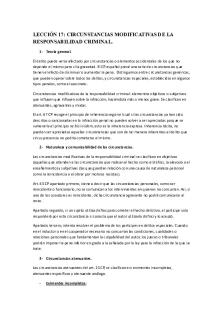CJ - 3 7 17 - Lecture notes 14 PDF

| Title | CJ - 3 7 17 - Lecture notes 14 |
|---|---|
| Course | Intro Criminal Justice |
| Institution | University of Alabama |
| Pages | 3 |
| File Size | 79.2 KB |
| File Type | |
| Total Downloads | 64 |
| Total Views | 139 |
Summary
CJ 101 - Klutz...
Description
Visible Crime ● ● ●
“Street Crimes” Majority of law enforcement resources Three categories: ○ Violent Crime - involve physical injury/death ○ Property Crime - involve property being taken/destroyed ○ Public Order Crimes - minor; panhandling, vandalism
Murder and nonnegligent (voluntary) manslaughter ●
●
Willful (nonnegligent) killing of one human being by another (intent is present) ○ First degree murder - Premeditated, intentional killings, felony murder (commission of a violent felony) ■ Felony murder is only exception to premeditation of first degree murder ■ Could be 30 secs - 1 min of planning beforehand, still 1st degree ○ Second degree murder - Unplanned (death of victim was distinct possibility -reckless action) ○ Voluntary manslaughter - intentional killing in which the offender had no prior intent (not premeditated) to kill ■ (“heat of passion”) ■ AKA “third degree murder” ○ Involuntary manslaughter - commit a reckless action, but no intent ■ Could be considered second degree murder in some states/cases Murder = purposeful killing, manslaughter = accidental (generally)
Forcible Rape ●
Updated definition from FBI: includes males and not just including “forcible” (could be unconscious, physically/mentally disabled, incapacitated by drugs/alcohol, etc.)
Robbery ●
Taking or attempting to take anything of value from the care, custody, or control of a person/persons by force or threat of force or violence and/or by putting victim in fear ○ Don’t have to hurt victims -- put them in a state of fear
Aggravated Assault ●
Unlawful attack by one person upon another for the purpose of inflicting severe or aggravated bodily injury
Property Crimes ● ●
Object of theft-type offenses is taking money/property, no force/threat against victims Burglary, Larceny-theft, Motor Vehicle Theft, Arson
Burglary ● ●
Unlawful entry of a structure to commit felony/theft Use of force to gain entry does not have to occur to be classified as burglary
Larceny-Theft ● ● ●
Unlawful taking, carrying, leading, riding away w/ property from possession of another Stealing property w/o violence or fraud Ex) bicycle theft, motor vehicle parts, shoplifting, etc.
Arson ●
Willful/malicious burning/attempting to burn, w/ or w/o intent to defraud, a dwelling house, public building, motor vehicle/aircraft, personal property, etc.
Public Order Crimes ● ● ●
Acts that threaten general well-being of society and challenge accepted moral principles Ex) public drunkenness, panhandling, vandalism, disorderly conduct Concern with these minor offenses is that they will lead to more serious crime/add ot urban decay
Elements of a Crime ●
●
●
Actus Reus - evil act (guilty act) ○ Act/conduct that is prohibited ○ Must be voluntary act or qualifying omission ■ Voluntary - performed consciously as a result of effort (involuntary doesn't count as actus reus) ■ Omission - failure to perform an act when physically capable Mens Rea - evil mind (guilty mind) ○ Level of intent to commit actus reus ○ ex) varying degrees of murder Attendant Circumstances
○ ○
●
Specific circumstances which must surround the actus reus (criminal act) ex) if speeding in a place where there are pedestrians, low speed limit, etc. then it is a crime, but if speeding on private property with no people in danger, it is not a crime Causation of Result ○ Result - occurs because of the commission of the actus reus ○ ex) convicted of homicide (result - death of another human)
Strict Liability ● ● ●
Narrow range of crimes that are exceptions to requirement of actus reus + mens rea = crime Offenses that are punished w/o regard to ind’s state of mind ex) Accidentally killing someone b/c thought gun was unloaded (Reckless, but no intent)
Direct vs. Circumstantial Evidence ● ●
Direct evidence - demonstrates proof beyond a reasonable doubt Circumstantial evidence (indirect evidence) - requires inference from a jury...
Similar Free PDFs

CJ - 3 7 17 - Lecture notes 14
- 3 Pages

3 7 17 - Lecture notes 8
- 1 Pages

Ethics 14 - Lecture notes 3-7
- 6 Pages

CJ Chap 7 Notes
- 4 Pages

Lecture 14-17 Transplantation
- 15 Pages

3 Teaching - Lecture notes 17
- 4 Pages

LecciÓn 17 - Lecture notes 17
- 6 Pages

Chapter 17 - Lecture notes 17
- 15 Pages

Chapter 17 - Lecture notes 17
- 7 Pages

Lecture notes, lecture 14
- 3 Pages

08 Topik 7 - Lecture notes 1-14
- 33 Pages

Chapter 14 - Lecture notes 14
- 5 Pages

Bafin 3 - Lecture notes 7
- 4 Pages

CRM - Lecture notes 3-7
- 3 Pages
Popular Institutions
- Tinajero National High School - Annex
- Politeknik Caltex Riau
- Yokohama City University
- SGT University
- University of Al-Qadisiyah
- Divine Word College of Vigan
- Techniek College Rotterdam
- Universidade de Santiago
- Universiti Teknologi MARA Cawangan Johor Kampus Pasir Gudang
- Poltekkes Kemenkes Yogyakarta
- Baguio City National High School
- Colegio san marcos
- preparatoria uno
- Centro de Bachillerato Tecnológico Industrial y de Servicios No. 107
- Dalian Maritime University
- Quang Trung Secondary School
- Colegio Tecnológico en Informática
- Corporación Regional de Educación Superior
- Grupo CEDVA
- Dar Al Uloom University
- Centro de Estudios Preuniversitarios de la Universidad Nacional de Ingeniería
- 上智大学
- Aakash International School, Nuna Majara
- San Felipe Neri Catholic School
- Kang Chiao International School - New Taipei City
- Misamis Occidental National High School
- Institución Educativa Escuela Normal Juan Ladrilleros
- Kolehiyo ng Pantukan
- Batanes State College
- Instituto Continental
- Sekolah Menengah Kejuruan Kesehatan Kaltara (Tarakan)
- Colegio de La Inmaculada Concepcion - Cebu

